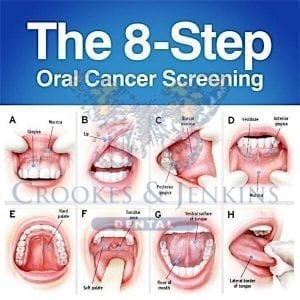
Smoking is the principle risk factor for oral cancer, mucosal diseases, halitosis and periodontitis. Smoking has a number of well documented detrimental effects orally.
It has been estimated that tobacco use accounts for more than 90% of oral cancers. Smokers have a three-fold increased risk of oral cancer, and the smoking-associated risk of oral cancer is both dose and duration dependent.
Other concerns
- Damaged Teeth and Gums
- Yellow teeth
- Gum disease
- Persistent bad breath
- Increased chance of tooth loss
The incidences of oral cancer are increasing and little progress appears to have been made in reducing the incidence and number of deaths associated with the disease.
Early detection, diagnosis and treatment of oral cancer has been shown to significantly increase the survival rate of those with the disease. In most cases, however, a diagnosis does not occur until cancer has advanced considerably. Mortality of oral cancer is particularly high not because it is difficult to diagnose, but because it is frequently asymptomatic and therefore it is diagnosed at a late stage.
Often it is only discovered when cancer has already metastasised, usually to the lymph nodes of the neck. Prognosis, once cancer has metastasised, is worse than when it is confined to a localised intraoral area.
Detection/Warning Signs
Your Dental professional is the first line of defence in the early detection and monitoring of oral cancers.
The sites of involvement of oral cancer are easily visible and accessible to a dental professional during a routine dental examination without requiring specialised equipment. Systematic examination of the oral tissues helps to reduce the chance that lesions will be missed. Oral cancer most commonly affects the tissue of the lips or the tongue. It may also occur on the floor of the mouth, cheek lining, or roof of the mouth.

Signs and Symptoms of oral cancer may include –
- Any sore in the mouth, or on the face and neck that does not heal in two weeks
- Swellings, lumps or bumps on the lips, or anywhere inside the mouth
- White, red or dark patches in the mouth
- Repeated bleeding in the mouth.
- Numbness, loss of feeling or pain in any area of the mouth, face or neck.
Prevention
Step one is to quit smoking! Within a few years of successful quitting, the risk of oral cancer is reduced by 30%. After 20 years the risk of oral cancer is reduced by 80%!
Regular visits to your dentist will ensure that any health risks are detected before it’s too late. Contact Crookes and Jenkins Dental today for a consultation and look after your oral hygiene!
